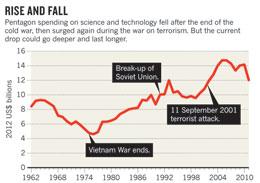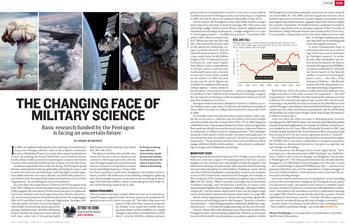wer of the Pentagon: The changing face of military science
Basic research funded by the Pentagon is facing an uncertain future.
In 2005, as roadside bomb attacks were claiming ever more lives in Iraq, senior Pentagon officials called on the academic community to join a 'Manhattan Project' to counter these improvised explosive devices. By invoking the Second World War race to build the atomic bomb, military leaders seemed to be pushing for a massive investment in science that could, like the first nuclear weapon, turn the tide of war.
Academics responded with a collective shrug. The Pentagon's grand rhetoric wasn't matched with any great influx of funding for science, and it wasn't clear how any one technology could help fight a loosely organized, deliberately low-tech enemy. Besides, says Julia Erdley, deputy science adviser to the Pentagon's Joint Improvised Explosive Device Defeat Organization, "we are looking for near-term solutions".
Six years later, the Department of Defense (DOD) has spent more than US$17 billion on countering improvised explosive devices, but, as Erdley suggests, the vast majority of that money has gone on implementing known solutions such as stronger armour for vehicles and personnel, not advanced research. Roadside bombs remain the single biggest killer of US and allied troops in Iraq and Afghanistan. Pentagon officials now admit that there is no technological 'silver bullet' for preventing, detecting and disarming roadside bombs, and their Manhattan project rhetoric has long since been replaced with more sober talk of disrupting highly distributed terrorist networks (see Nature 471, 566–568; 2011).
The failure to mobilize the scientific community for the war on terror stands in stark contrast to what happened in the cold war, when Pentagon-supported science boomed, and was viewed as a crucial asset to counter Soviet technological prowess. Today's military has to operate in much more ambiguous and complex environments, in which 'soft' skills such as trust-building, intelligence-gathering and cultural insight may prove as decisive as any technological advantage. Given this new military reality, it is becoming less clear what science and technology research has to offer.
Broken programmes
That uncertainty may help to explain what some now see as a lack of sustained Pentagon support for blue-sky basic science and a preference for applied research with a short-term pay-off. "We believe that important aspects of the DoD basic research programs are 'broken' to an extent that neither throwing more money at these problems nor simple changes in procedures and definitions will fix them," wrote the JASONs, a defence advisory group made up of independent scientists, in the most recent publicly available assessment of Pentagon science and technology. (Completed in 2009, the JASON report was released to the public in May 2010.)
On the surface, the Pentagon's science base looks healthy enough, and it supports a vast array of research (see page 369). The science and technology budget, which consists of basic research, applied research and advanced technology development — budget categories 6.1, 6.2 and 6.3 in Pentagon parlance — has fallen from its post-11 September 2001 peak in 2005, when it reached some $14.7 billion per year (see 'Rise and fall'). But most of that decline came in the advanced-technology category, not basic research. And the total still stands at about $12 billion a year, nearly twice the $6.8 billion budget of the US National Science Foundation, and much higher than defence science expenditures in Europe, where countries have traditionally spent only a fraction of what the United States spends on the military. In 2009, the most recent year for which figures are available, the members of European Defence Agency — every country in the European Union except Denmark — spent an aggregate of only €2.26 billion (US$3.1 billion) in the 'research and technology' category, the vast majority of which goes to the development of advanced aircraft and other weaponry, not science.
 Click for larger image
Click for larger image
Pentagon research also had a champion in former US defence secretary Robert Gates, a one-time CIA director who had been president of Texas A&M University in College Station before he came to the DOD in 2006.
For example, Gates was well aware that in many academic fields, notably the social sciences, relations with the military have been fraught and often hostile since the Vietnam War (1955–75). In 2008, hoping to rebuild those ties, Gates proposed Minerva: a basic-science programme that would specifically focus on the social sciences. Gates saw Minerva as emblematic of military science's changing mission. "The challenges facing the world require a much broader conception and application of national power than just military prowess," he said in announcing the programme. "The government and the Department of Defense need to engage additional intellectual disciplines — such as history, anthropology, sociology and evolutionary psychology."
Magnificent seven
Beginning with the president's fiscal year 2012 budget request this past February, Gates set a target of 2% annual growth in the basic-science budget over the coming years, and pledged to hold the applied- and advanced-technology accounts steady. That was particularly heartening news for those disciplines to which defence funding is crucial. About one-third of all the funding for oceanography research and computer science in the United States comes from the Pentagon, for example, as does a majority of the funding for mechanical engineering (see Nature 466, 656–657; 2010). "Physics research is no longer tied so exclusively to military funding," says David Kaiser, a historian of science at the Massachusetts Institute of Technology in Cambridge, "although it still has a large role." And the defence department is also now the largest single source of funding for research into traumatic brain injury (see page 390).
Shortly before stepping down on 30 June this year, Gates signed off a new science and technology plan for the Pentagon. The policy includes a list of priorities — which Pentagon insiders immediately dubbed the 'magnificent seven' — to be used for budget planning over the next five years.
And yet, Gates's efforts also illustrate some of the many strains in the Pentagon's science and technology programme. Minerva, in particular, has met with decidedly mixed reactions, as academics question whether the Pentagon has any business setting the course of social-science research (see Nature 455, 583–585; 2008). And the magnificent-seven list, which includes topics such as research to counter weapons of mass destruction, and engineering resilient systems, arguably hasn't done much to inspire the scientific community. "It would be hard to categorize it as bold or prescient," says Mark Lewis, an aerospace engineer at the University of Maryland in College Park and a former chief scientist of the US Air Force. It is essentially a compendium of the individual military services' wish lists. A Pentagon spokesperson also says that there are no funding goals tied to the magnificent seven.
A more fundamental issue is what many observers see as a lack of high-level vision and coordination for Pentagon research. In earlier decades, that coordination was carried out by the director for defence research and engineering (DDR&E), a position established in 1958 after the Soviet launch of the Sputnik satellite. Located in the Pentagon's power centre — the Office of the Secretary of Defense — this director oversaw all of the department's science and technology programmes.
But in the late 1970s, the position ceded much of its authority over budget and policy to the under secretary for acquisition — the chief weapons buyer. The DDR&E, recently renamed the assistant secretary of defence for research and engineering, was left with a limited staff, overseeing a vast portfolio of science accounts at the individual services and the Pentagon-wide Defense Advanced Research Projects Agency. In recent years, the office has become marginalized, with its staff fending off spending cuts in the science budget, rather than being a driving force in military science policy.
And even when the office succeeds in defending basic research, according to the 2009 JASON report, the research inexorably gets pushed towards immediate applications. In a sample of 258 basic-research projects funded by the Air Force Office of Scientific Research in 2007, and a similar sample funded by the Army Research Office, the group found that as many as 81% "are not, even by a generous stretch, 6.1 research".
The JASONs urged the defence department to elevate and strengthen the DDR&E office, and make it independent of weapons acquisition. But the defence-department bureaucracy has given no sign that any such change is in the offing.
In the meantime, the Pentagon faces a more urgent threat. "We're starting to see a downward trend in R&D funding," says Todd Harrison, a fellow at the Center for Strategic and Budgetary Assessments in Washington DC. The Obama administration has already asked the Pentagon to cut $400 billion from its budgets over the next 12 years — the current budget is about $700 billion per year — and there's no guarantee that those cuts won't be expanded as Congress struggles to trim the US federal deficit, or that the money won't come from the science and technology budget.
Lewis sees Gates's commitment to increasing basic-science spending as one of the most important changes in the Pentagon's science policy over the past few years. The question now, however, is whether Gates's successor, former CIA director Leon Panetta, will uphold that commitment. Lewis points to the new defence secretary's confirmation hearings on Capitol Hill, when he was specifically asked that question. Panetta replied that he valued basic research — but that "all defence appropriations must be considered during this time of budget constraints".
In other words, everything is on the table for cuts, including science. "That would be a profound change," says Lewis.
See Editorial page 369


